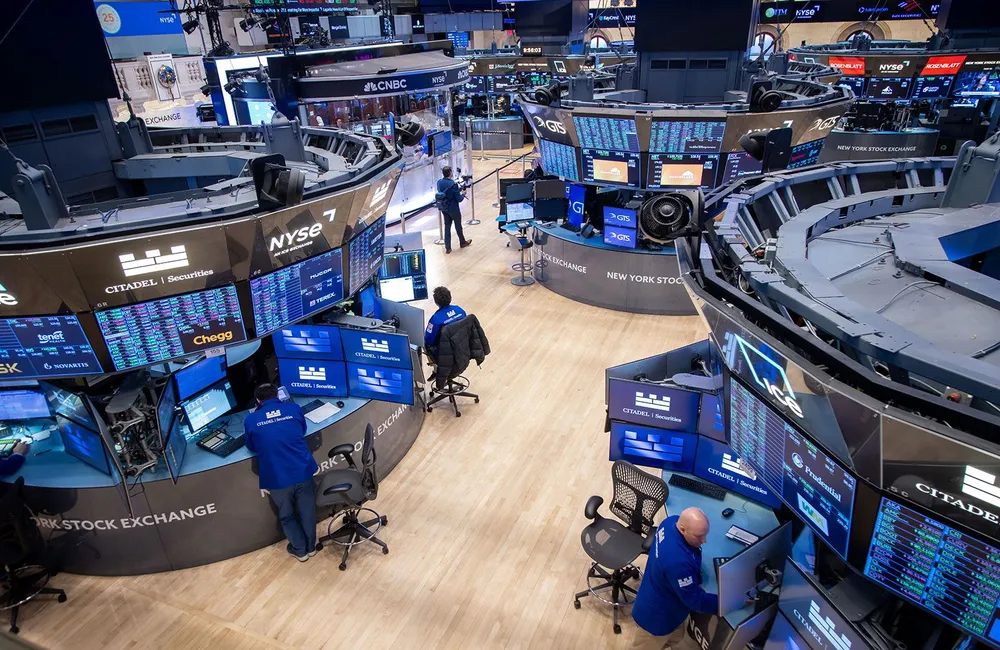ASX futures fell 33 points, or 0.5 per cent, to 7075 just before 8.00 am AEST, indicating a weak start for trade.
U.S. stocks and bond yields plunged Friday amid heightened tensions between Russia and Ukraine that drove investors into safe assets.
The three main US stock indexes all closed down on the day, wrapping up another rock ’n’ roll week on Wall Street. Just days ago, indexes looked poised to push their weekly winning streak to three. But simultaneous worries about escalating inflation and geopolitical turmoil sent stocks downward in the last two days of the week.
The S&P 500 plunged 1.9 percent on Friday. Its two-day loss over Thursday and Friday totaled 3.7%, the index’s biggest two-day percentage drop since October 2020. The technology-focused Nasdaq Composite dropped 2.8%. The Dow Jones Industrial Average fell by 1.4%.
The three major indexes all closed out the week in the red. For the week, the S&P 500 and Nasdaq Composite fell 1.8 percent and 2.2 percent, respectively. The weekly loss on the Dow was 1%.
At home, the S&P/ASX 200 finished 1.0% off at 7217.3, cutting its weekly gains as technology stocks sold off. Volatile US indices shed ground against the backdrop of climbing bond yields as the benchmark ended a three-day winning streak.
On the ASX, Block's listed securities Megaport, Appen and Life360 declined between 6.7% and 6.9% as the tech sector retraced much of its recent gains, although ended the week 1.8% higher.
NAB, Westpac and ANZ were all higher, although a 2.2% drop in Commonwealth Bank and weakness elsewhere weighed on the financial sector.
Only the materials sector gained, up 0.3% on the back of iron-ore miners.
For the week the ASX 200 gained 1.4%.
On other world markets, the pan-continental Stoxx Europe 600 lost 0.6 percent. In Asia, the Shanghai Composite Index declined 0.7% and Hong Kong’s Hang Seng Index nudged down 0.1%. Japan’s markets were shut for a public holiday.
In commodities, gold futures rose 0.3% to $US1842. $US 1.10 an ounce; Brent crude was 3.3% higher at $US94. 44 a barrel, its highest level since 2014 as volatility raged over Ukraine; Iron ore fell 8% to US$120.53.
In bond markets, the yield on the Australian 10-year bond pushed up to 2.21%. The yield on 10-year US Treasury was down at 1.94%, with fears that an invasion of Ukraine by Russia is imminent. Yields fall when prices rise.
The Australian dollar was fetching 71.33 US cents at 8.00 am AEST, compared with the previous day's close of 71.64. The WSJ Dollar Index, which tracks the US dollar against 16 other currencies, increased to 89.89.
Asia
Asian markets turned to China, where stocks finished lower on Friday amid losses in biotech and renewable energy-related sectors. The markets were also finding overhang from the addition of more than 30 Chinese entities to the US “unverified list” last week, which would expose them to more stringent export controls, Nomura said. The electric-vehicle battery maker CATL fell 5.4%, and LONGi Green Energy dropped 4.9%, while WuXi AppTec fell 3.2%, and Shenzhen Mindray Bio-Medical Electronics sank 4.0% -- although none was on the list. Coal miners and lenders rose. Yankuang Energy gained 5.2% and China Merchants Bank rose 2.0%. The Shanghai Composite Index ended a four-day rally, falling 0.7%. The Shenzhen Composite Index fell 1.7% and the ChiNext Price Index tumbled 2.8%, for a weekly loss of 5.6%.
In Hong Kong, stocks closed the session lower, breaking a two-day recovery earlier this week. The benchmark Hang Seng Index slipped 0.1%. Drug developers were the biggest drag, with CSPC Pharmaceutical sinking 5.9% to be the worst performer on the index. The stock’s drop came a day after two days of strong increases after the company said it bought a smaller biotech company to expand its product portfolio. Sino Biopharm dropped 2.1%, and Wuxi Biologics fell 2.7% more amid American regulatory uncertainty.
Japanese equity markets were closed for public holiday.
Europe
European stocks dipped while Wall Street equities extended a drop from Thursday that was instigated by stronger-than-expected US inflation data. The pan-European Stoxx 600 slipped 0.6%.
In the meantime, European stocks posted a positive week despite Friday’s retreat, “buoyed by the ability of most companies to be able to pass on price rises and maintain their earnings guidance thresholds,” said Michael Hewson, an analyst at CMC Markets. The Stoxx 600 index has gained 1.6 percent for the week.
The FTSE 100 in London surrendered 0.1 percent, on Friday as European markets recouped some of the worst of the day’s losses after starting on the back foot following Thursday’s heavy drops in the U.S., said Michael Hewson, chief market analyst at CMC Markets UK.
The FTSE 100 ended the week 1.9% higher, its second weekly gain in a row, in spite of the drop on Friday. Unilever and British American Tobacco shares closed up on the day as the market took in full year numbers from both. BP and Shell are also up again, having dipped back on Thursday after a weaker oil price, Hewson says.
North America
US stocks and bond yields tumbled Friday, as worsening tensions between Russia and Ukraine drove investors to safer assets.
All three major US stock indexes ended the day in the red, closing out another turbulent week on Wall Street. As recently as two days ago, it looked like indexes might be off to a three-week winning streak. But fears about rising inflation and geopolitical turmoil roiled markets, sending stocks sliding over the last two days of the week.
On Friday, the S&P 500 dropped 1.9 percent. Its two-day loss over Thursday and Friday added up to 3.7%, the index’s largest two-day percentage drop since October 2020. The technology-focused Nasdaq Composite fell 2.8%. The Dow Jones Industrial Average fell 1.4%. The three major indexes all finished the week in the red. For the week, the S&P 500 and Nasdaq Composite fell 1.8% and 2.2%, respectively. The Dow finished the week 1% lower.
The White House said Friday afternoon that it believes Russia may invade Ukraine at any moment and called on Americans to leave the country as soon as possible. Investors, in response, pulled money out of stocks and ran for safety in government bonds. The backpedaling from stocks added to a selloff that started Thursday after data showed inflation reached 7.5% in January, reviving concerns that the Federal Reserve may need to tighten monetary policy more aggressively than previously believed.
The mix of economic news and geopolitical tensions added fresh anxiety to a stock market that’s already on shaky footing. Stocks were already lower for 2022 before this week, following a rocky January.
“There were a lot of shadows that were looming and that are now suddenly on everybody’s radar, and they’re all contributing to the elevated volatility,” said John Lynch, chief investment officer at Comerica Wealth Management. [[Hmm]] They need to help rev up the economy and support more positive visions for the economy, rather than “the market has been counting on diplomacy and to a large extent ignoring the threat” on the Ukrainian border.
This week, the stock market’s volatility echoed through asset classes. Oil prices surged on Friday, with Brent crude, the international oil benchmark, inching up 3.3 percent, to $94.44 a barrel, its highest settle since September 2014.
In the bond market, the yield on the benchmark 10-year Treasury note fell back, a day after rising above 2 percent for the first time since mid-2019. The yield, which closed Thursday at 2.028%, dropped to 1.94% Friday. Bond prices and yields move in opposite directions.
The wild moves across the market erased some of the calm that had returned to markets earlier in the week. Before Thursday’s violent selloff, the S&P 500 had gained in seven of the last nine sessions.
As markets opened Friday, however, many investors were focused mostly on whether the Fed is about to ramp up interest-rate increases this spring to dampen soaring prices and cool the economy. Many investors were attempting to parse predictions on how big and how often the rate hikes could be.
“Inflation is sort of hot now, it’s in the public’s eye. It has turned into a political question,” said Florian Ielpo, head of macro at Lombard Odier Investment Managers. “This is something that worries us, we have an increasing risk of monetary policy mistakes. That is the single biggest risk we are seeing in 2022.”
By Friday afternoon, though, attention had shifted to the Ukrainian border. The Cboe Volatility Index — known as Wall Street’s so-called fear gauge, or the VIX soared, closing at 27.36, its highest finish since late January.
Only the energy and utilities groups in the S&P 500 stocks finished the day in the green Friday. Occidental Petroleum climbed $2.30, or roughly 5.7 percent, to close at $42.98. Hess rose $3.80, or 4.1%, to settle at $96.20.
Zillow’s Class C shares rose $6.61, or 14 percent, to end at $55.40 after it posted a surge in revenue for its core unit, even as it lost $881 million on its shuttered home-flipping operations last year. The fintech company Affirm fell $12.13, or 21 percent, to $46.55 after its forecast for sales fell short of Wall Street’s expectations. It also plunged 21% Thursday.
Apollo Global Management dropped $4, or 5.7 percent, to $65.57 after it posted a weaker profit. The private-equity firm was close to a deal to acquire Worldline’s point-of-sale terminal business, The Wall Street Journal reported.




















